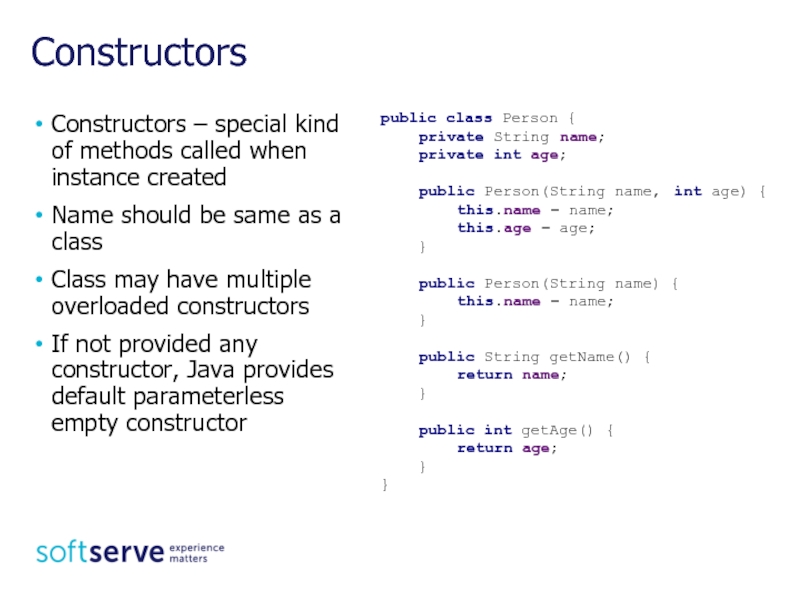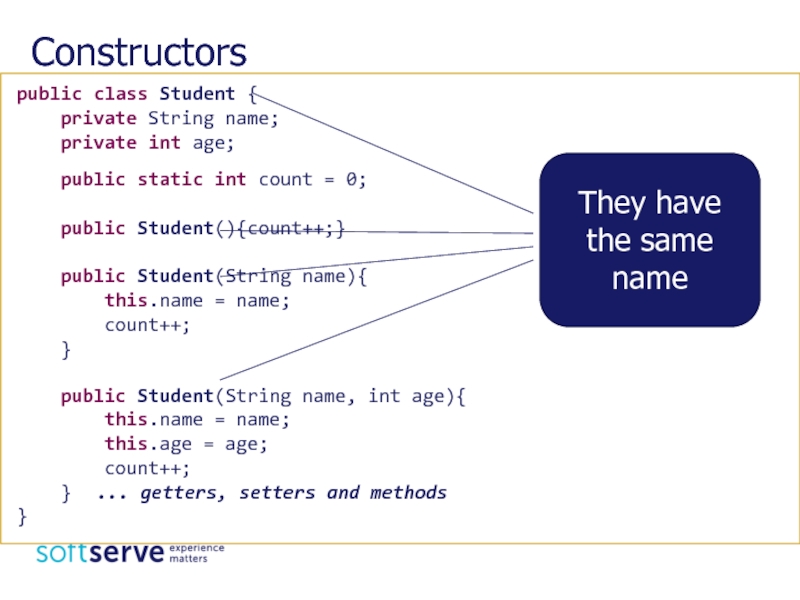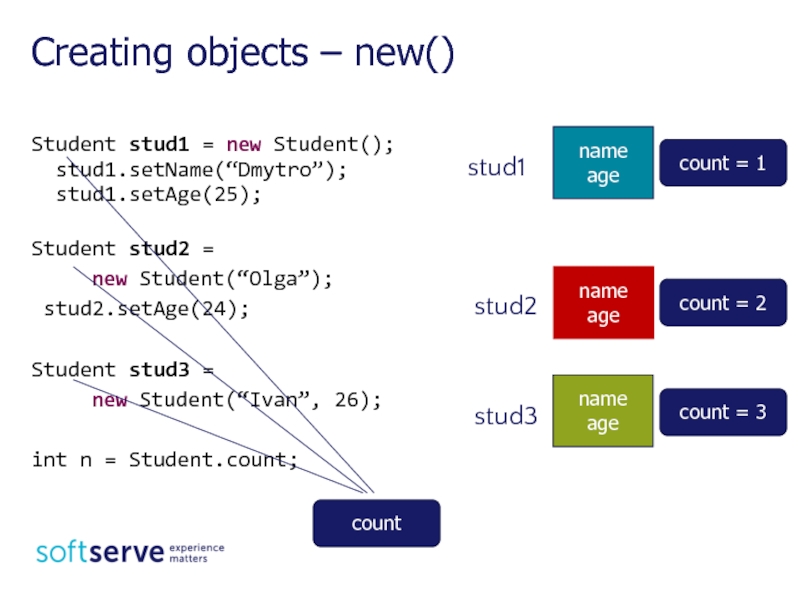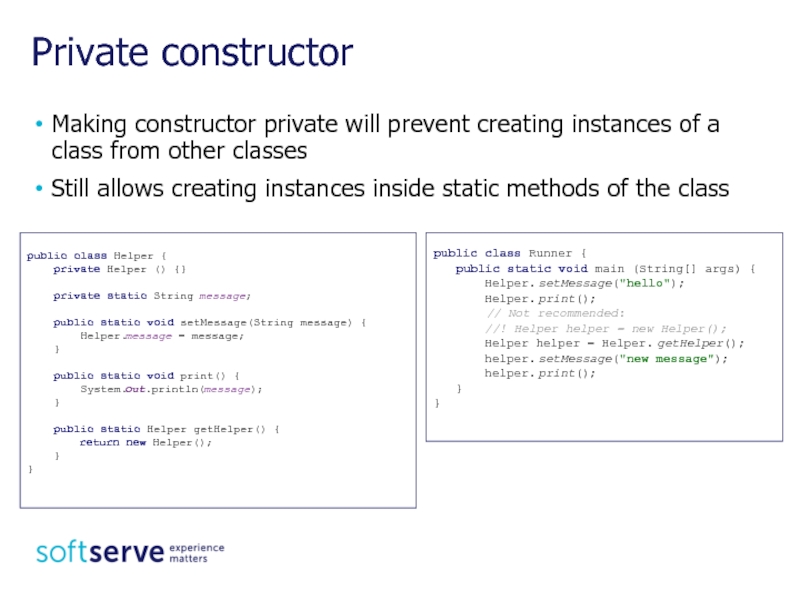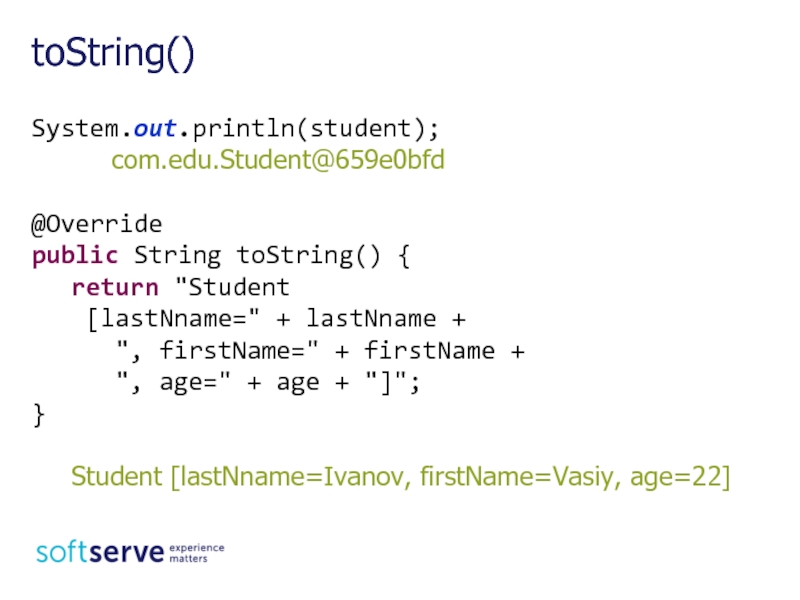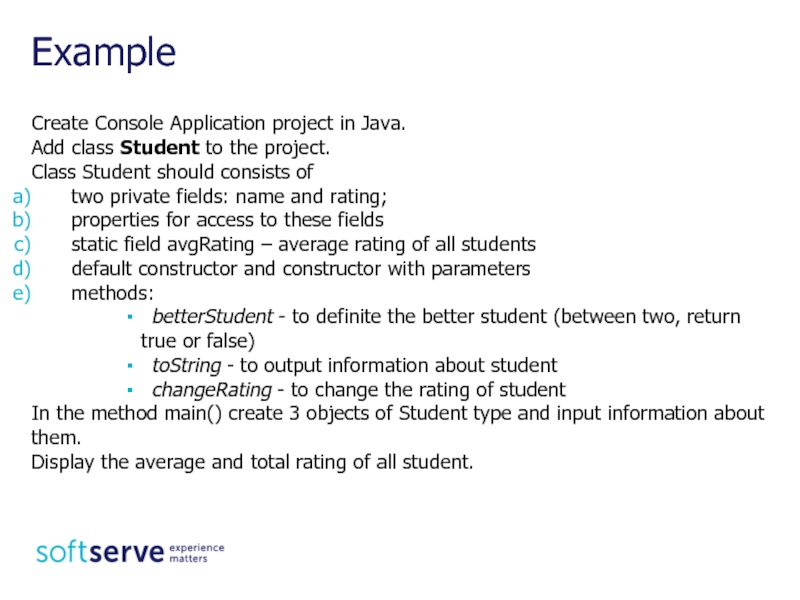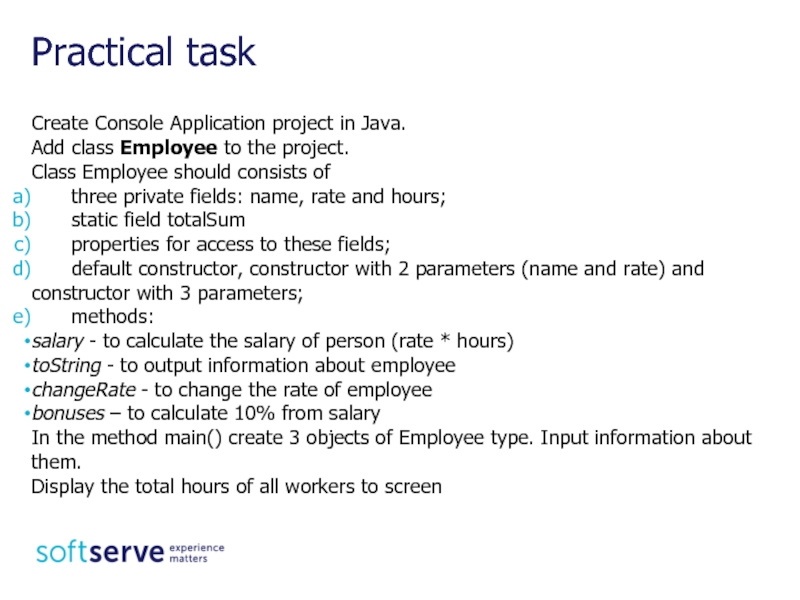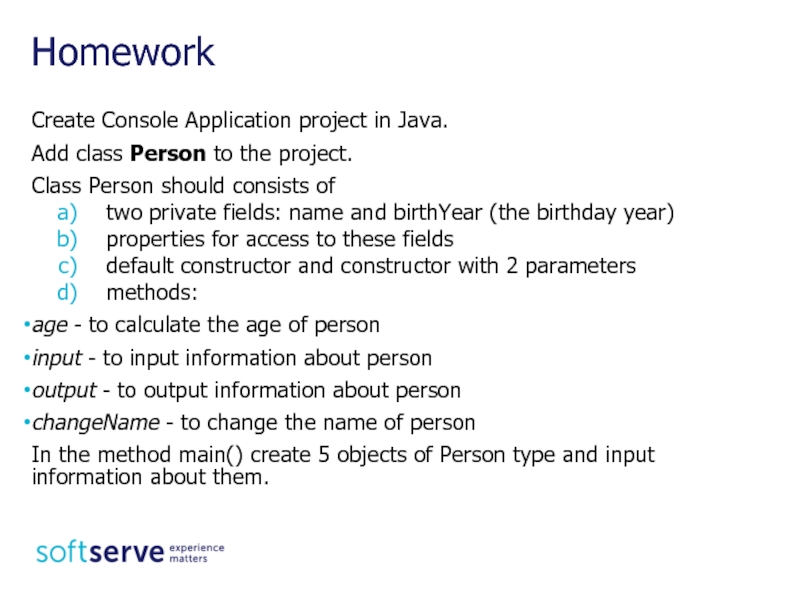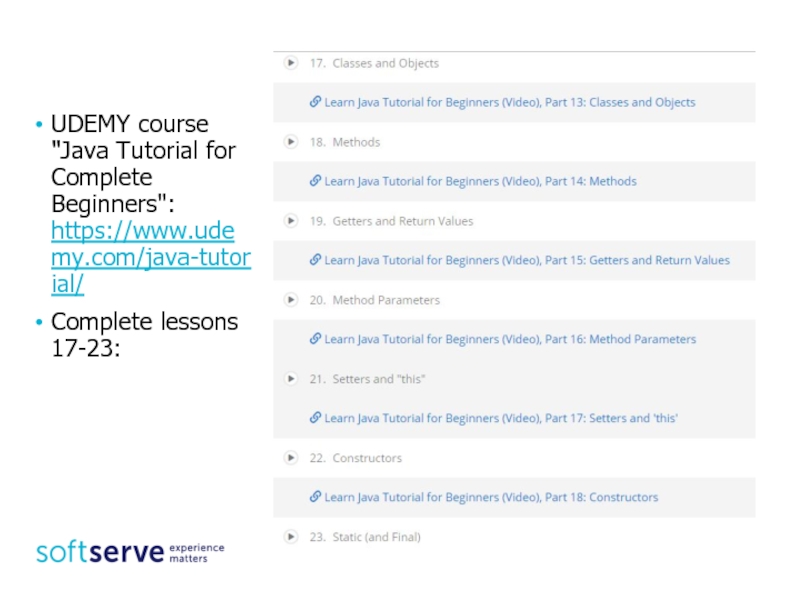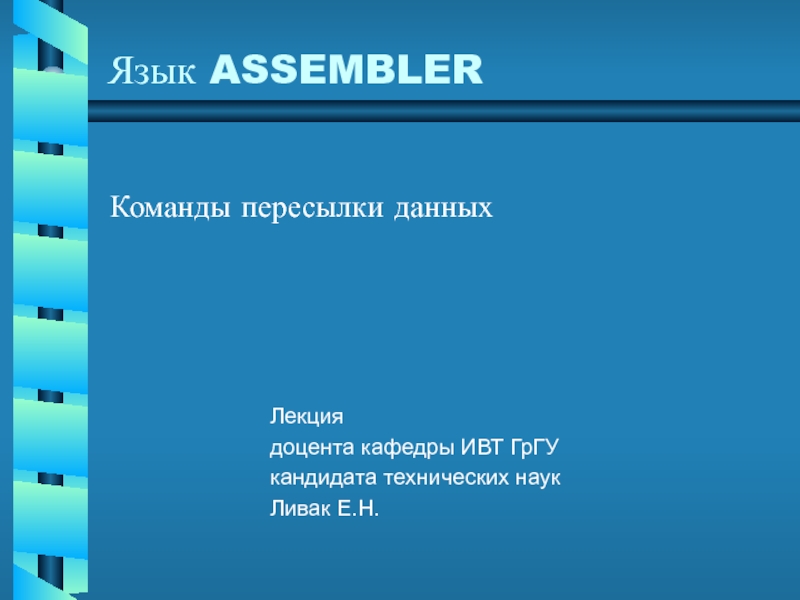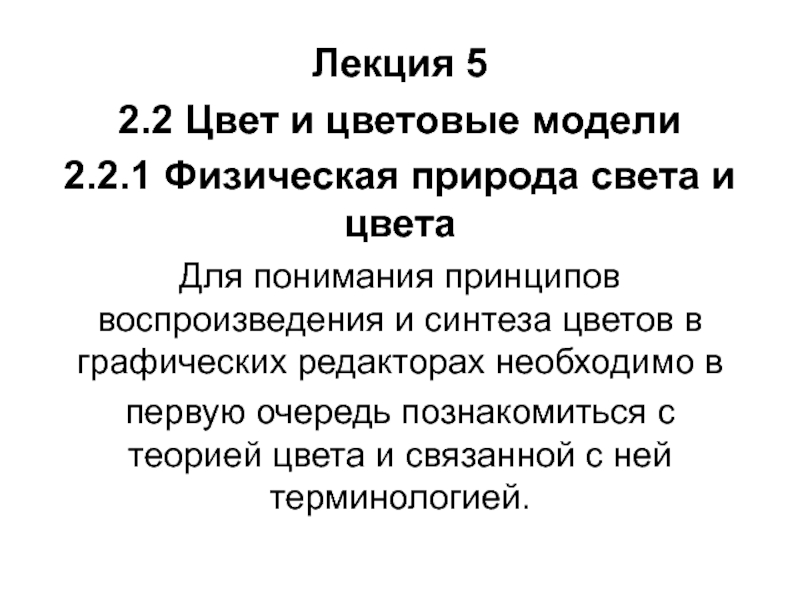- Главная
- Разное
- Дизайн
- Бизнес и предпринимательство
- Аналитика
- Образование
- Развлечения
- Красота и здоровье
- Финансы
- Государство
- Путешествия
- Спорт
- Недвижимость
- Армия
- Графика
- Культурология
- Еда и кулинария
- Лингвистика
- Английский язык
- Астрономия
- Алгебра
- Биология
- География
- Детские презентации
- Информатика
- История
- Литература
- Маркетинг
- Математика
- Медицина
- Менеджмент
- Музыка
- МХК
- Немецкий язык
- ОБЖ
- Обществознание
- Окружающий мир
- Педагогика
- Русский язык
- Технология
- Физика
- Философия
- Химия
- Шаблоны, картинки для презентаций
- Экология
- Экономика
- Юриспруденция
Class and Object. Java Core презентация
Содержание
- 1. Class and Object. Java Core
- 2. Agenda Class and Object Access to
- 3. A class is a prototype (template) from
- 4. class ClassName { // fields
- 5. Class public class Student {
- 6. public class Student {...} private int age;
- 7. Special Requirements to source files a source
- 8. Default values for fields
- 9. Widening (implicit or automatic) type casting take
- 10. Methods and overloading Methods are functions that
- 11. Variable length arguments Methods in Java support
- 12. The following class uses public access control:
- 13. The following class uses private access control:
- 14. Student student = new Student();
- 15. public class Sum { private
- 16. Keyword "this" this always points to current
- 17. Keyword 'static' Keyword 'static' indicates that some
- 18. Keyword 'static' public class Runner {
- 19. Constructors Constructors – special kind of methods
- 20. Constructors public class Student
- 21. Student stud1 = new Student();
- 22. Private constructor Making constructor private will prevent
- 23. System.out.println(student); com.edu.Student@659e0bfd @Override public String toString()
- 24. Create Console Application project in Java. Add
- 25. Create Console Application project in Java. Add
- 26. Create Console Application project in Java. Add
- 27. UDEMY course "Java Tutorial for Complete Beginners": https://www.udemy.com/java-tutorial/ Complete lessons 17-23:
- 28. The end
Слайд 2Agenda
Class and Object
Access to data
Fields of class
Getters and Setters
Constructors
Methods
Creating objects
Examples
Слайд 3A class is a prototype (template) from which objects are created
An
Class and Object
student1
Last name - Petrenko
First name - Ostap
Age - 19
List of courses – Java, MQC
Student
has
Last name
First name
Age
List of courses
can
Pass an exam
Enroll to course
student2
Last name - Romaniv
First name - Maryna
Age - 21
List of courses – Java, ATQC
Слайд 4 class ClassName {
// fields
variable1;
...
// constructors
// method body }
...
// method body }
// methods
// method body }
...
// method body }
Class
Слайд 5Class
public class Student {
private String lastName;
private String
private int age;
private Student(){}
public boolean passExam(String subject){
//do something
return true;
}
public void print(){
//do something
}
}
fields
constructor
methods
Слайд 6public class Student {...}
private int age;
public void print(){}
Class Package Subclass World
private Y — — —
(not) Y Y — —
protected Y Y Y —
public Y Y Y Y
Access to data
access specifier
data type
Слайд 7Special Requirements to source files
a source code file (.java) can have
name of this class should be exactly the same of file name before extension (including casing)
source code file can have any number of non-public classes
most code conventions require use only one top-level class per file
Слайд 9Widening (implicit or automatic) type casting take place when, the two
Type casting
int i = 100;
long l = i; //no explicit type casting required
float f = l; //no explicit type casting required
double d = 100.04;
long l = (long) d; //explicit type casting required
int i = (int) l; //explicit type casting required
When you are assigning a larger type value to a variable of smaller type, then you need to perform narrowing (explicit) type casting.
Слайд 10Methods and overloading
Methods are functions that are executed in context of
Always have full access to data of object
Object can have multiple methods with same name but different signature (type and order of parameters)
Signature doesn't include return type, methods can't be overloaded by return types
class Person {
String name;
public void print() {
System.out.println(name);
}
public void print(String s) {
System.out.println(s + " " + name);
}
}
Слайд 11Variable length arguments
Methods in Java support arguments of variable length
Should be
public class Util {
public static void print (String welcomeMessage,
Object... messages) {
System.out.print(welcomeMessage);
for (Object msg: messages) {
System.out.print(msg);
}
}
}
public class Runner {
public static void main (String[] args) {
Person person = new Person();
Util.print("Any ", "argment ", "possible",
10, 20.5, false, person);
}
}
Слайд 12The following class uses public access control:
public class Student {
public
public int age;
...
}
Student stud = new Student();
stud.name = “Krystyna”;
stud.age = 22;
Access to fields
Do not make so!
Слайд 13The following class uses private access control:
public class Student {
public String getName() {
return this.name;
}
public void setName(String name) {
this.name = name;
}
}
Getters and Setters
Слайд 14Student student = new Student();
student.setName(“Franko”);
String nameStud =
student.getName();
Getters
set
get
Слайд 15public class Sum {
private int a, b, c;
void setB(int n) { this.b = n; c = a + b; }
int getA() { return this.a; }
int getB() { return this.b; }
int getC() { return this.c; }
public void sum(int m, int n) {
this.a = m; this.b = n;
this.c = m + n;
}
}
Getters and Setters can be Complex
Слайд 16Keyword "this"
this always points to current object
can't lose context like JavaScript
not
often needed to distinguish between parameters and fields:
public class SomeClass {
private int a;
void setA(int a) { this.a = a;}
}
Слайд 17Keyword 'static'
Keyword 'static' indicates that some class member (method or field)
Static members should be accessible by class name (good practice, not required by language itself)
public class Helper {
private static String message;
public static void setMessage(String message) {
Helper.message = message;
}
public static void print() {
System.out.println(message);
}
}
Слайд 18Keyword 'static'
public class Runner {
public static void main (String[]
Helper.setMessage("hello"); Helper.print();
// Not recommended: Helper helper = new Helper(); helper.setMessage("new message"); helper.print(); }
}
Слайд 19Constructors
Constructors – special kind of methods called when instance created
Name should
Class may have multiple overloaded constructors
If not provided any constructor, Java provides default parameterless empty constructor
public class Person {
private String name;
private int age;
public Person(String name, int age) {
this.name = name;
this.age = age;
}
public Person(String name) {
this.name = name;
}
public String getName() {
return name;
}
public int getAge() {
return age;
}
}
Слайд 20
Constructors
public class Student {
private String name;
private
public static int count = 0;
public Student(){count++;}
public Student(String name){
this.name = name;
count++;
}
public Student(String name, int age){
this.name = name;
this.age = age;
count++;
} ... getters, setters and methods
}
They have the same name
Слайд 21
Student stud1 = new Student();
stud1.setName(“Dmytro”);
stud1.setAge(25);
Student stud2 =
stud2.setAge(24);
Student stud3 =
new Student(“Ivan”, 26);
int n = Student.count;
Creating objects – new()
count
Слайд 22Private constructor
Making constructor private will prevent creating instances of a class
Still allows creating instances inside static methods of the class
public class Helper {
private Helper () {}
private static String message;
public static void setMessage(String message) {
Helper.message = message;
}
public static void print() {
System.out.println(message);
}
public static Helper getHelper() {
return new Helper();
}
}
public class Runner {
public static void main (String[] args) {
Helper.setMessage("hello");
Helper.print();
// Not recommended:
//! Helper helper = new Helper();
Helper helper = Helper.getHelper();
helper.setMessage("new message");
helper.print();
}
}
Слайд 23System.out.println(student);
com.edu.Student@659e0bfd
@Override
public String toString() {
return "Student
[lastNname=" + lastNname +
", age=" + age + "]";
}
Student [lastNname=Ivanov, firstName=Vasiy, age=22]
toString()
Слайд 24Create Console Application project in Java.
Add class Student to the project.
Class
two private fields: name and rating;
properties for access to these fields
static field avgRating – average rating of all students
default constructor and constructor with parameters
methods:
betterStudent - to definite the better student (between two, return true or false)
toString - to output information about student
changeRating - to change the rating of student
In the method main() create 3 objects of Student type and input information about them.
Display the average and total rating of all student.
Example
Слайд 25Create Console Application project in Java.
Add class Employee to the project.
Class
three private fields: name, rate and hours;
static field totalSum
properties for access to these fields;
default constructor, constructor with 2 parameters (name and rate) and constructor with 3 parameters;
methods:
salary - to calculate the salary of person (rate * hours)
toString - to output information about employee
changeRate - to change the rate of employee
bonuses – to calculate 10% from salary
In the method main() create 3 objects of Employee type. Input information about them.
Display the total hours of all workers to screen
Practical task
Слайд 26Create Console Application project in Java.
Add class Person to the project.
Class
two private fields: name and birthYear (the birthday year)
properties for access to these fields
default constructor and constructor with 2 parameters
methods:
age - to calculate the age of person
input - to input information about person
output - to output information about person
changeName - to change the name of person
In the method main() create 5 objects of Person type and input information about them.
Homework
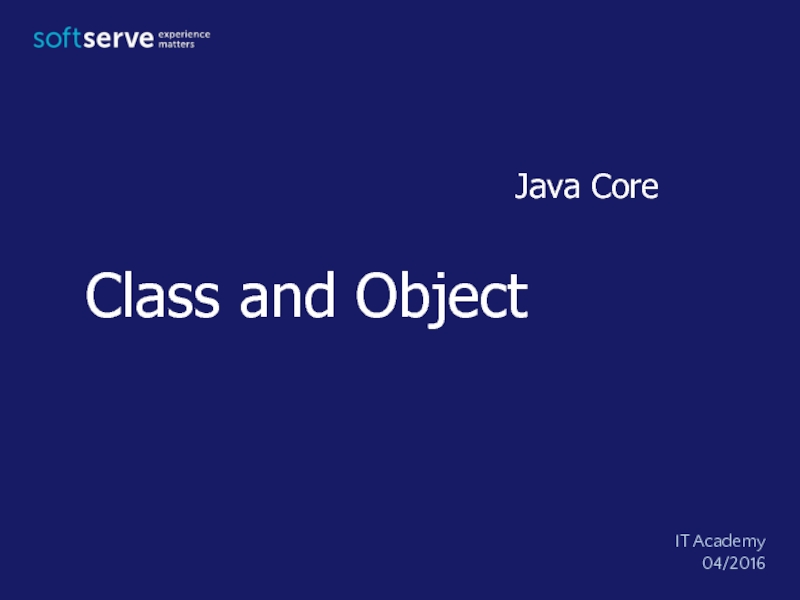
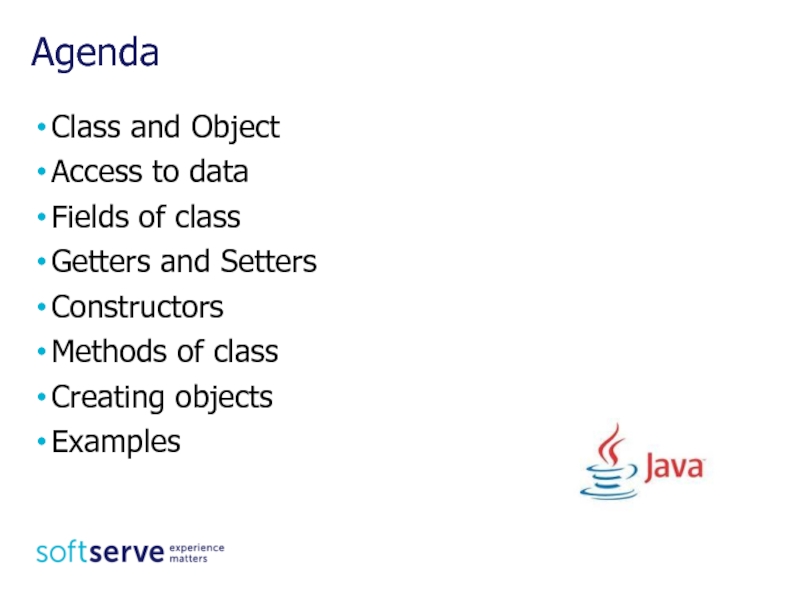
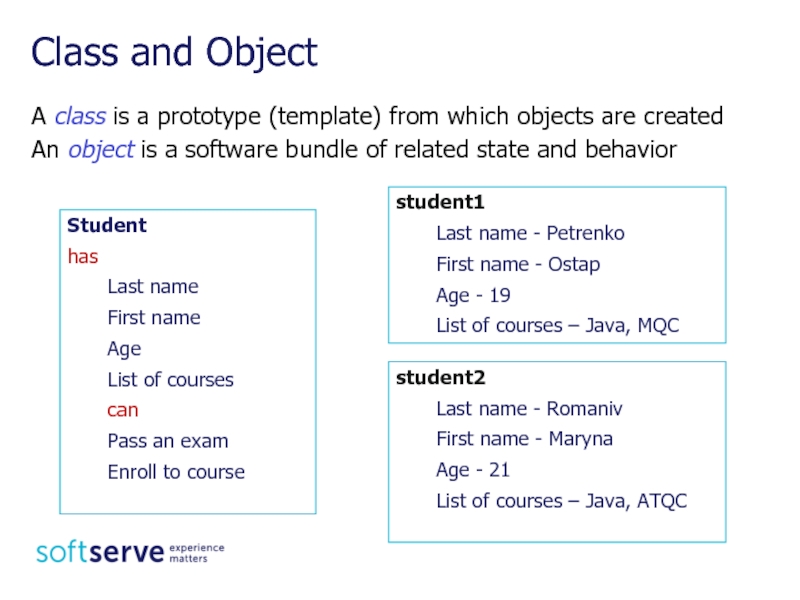
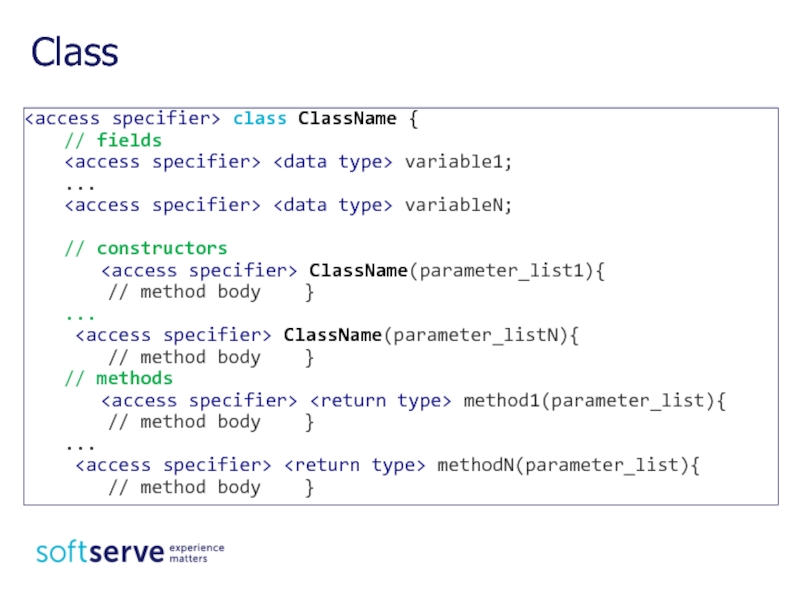
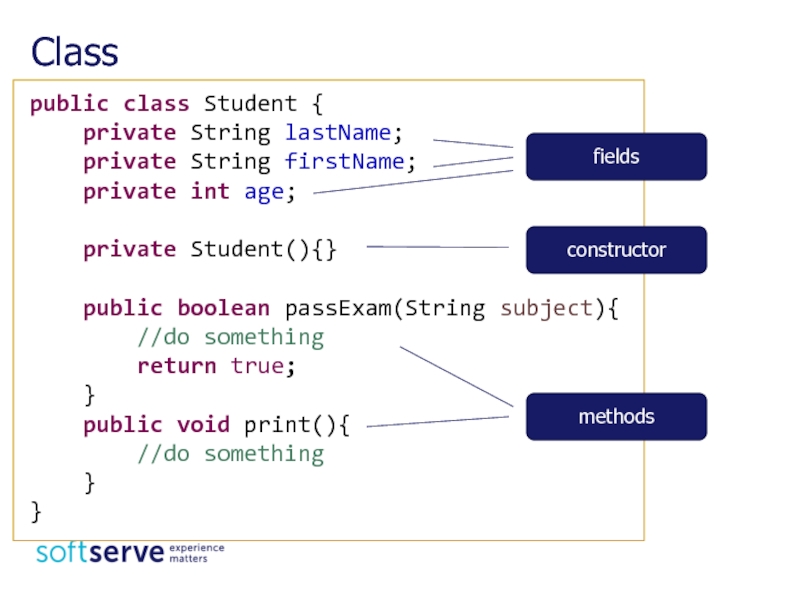
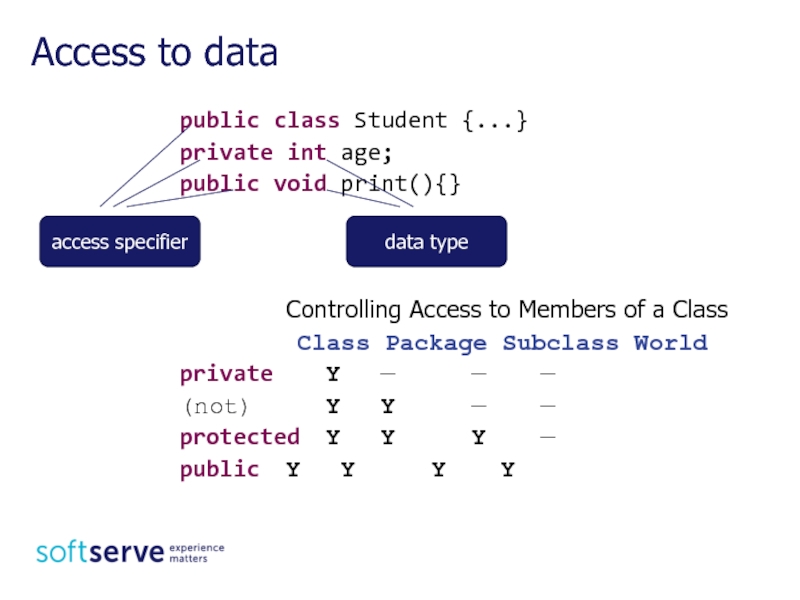
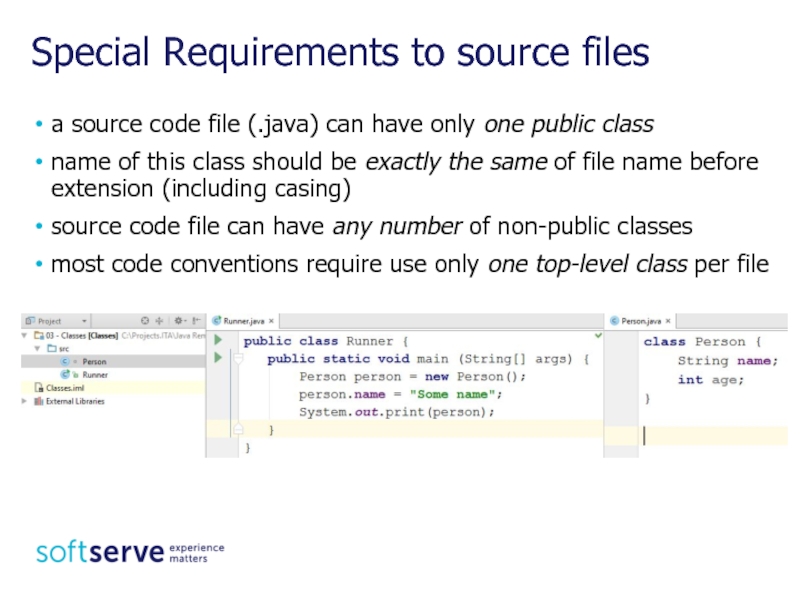
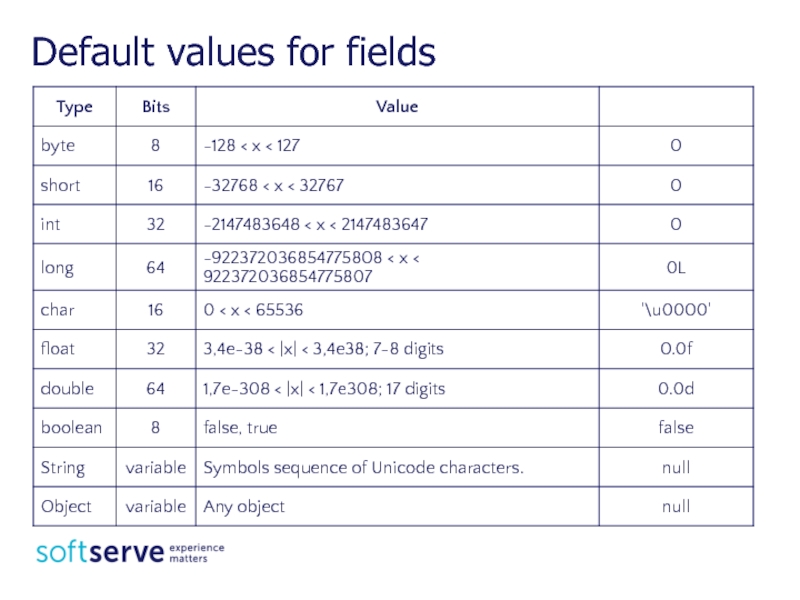
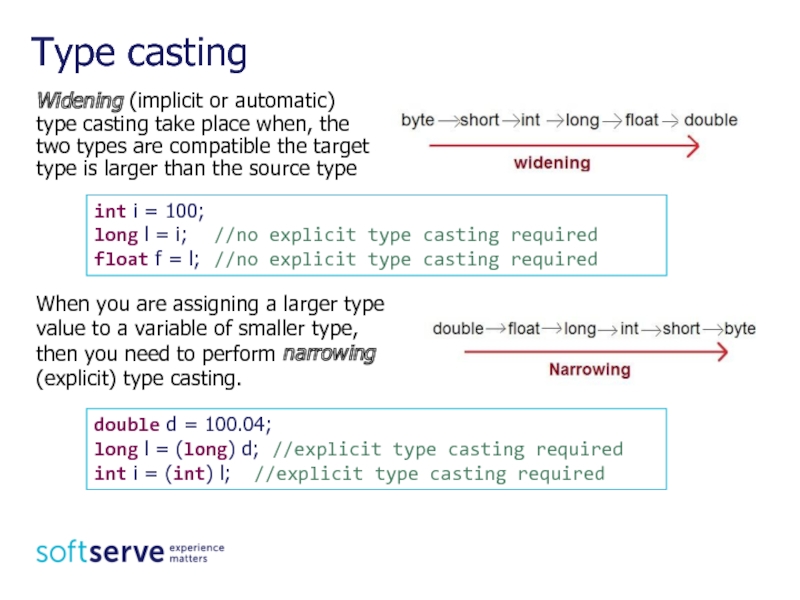
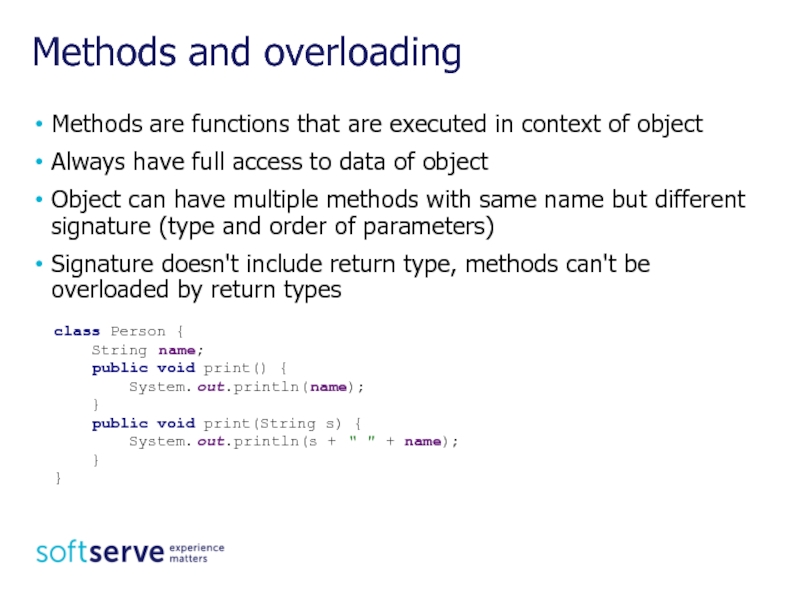
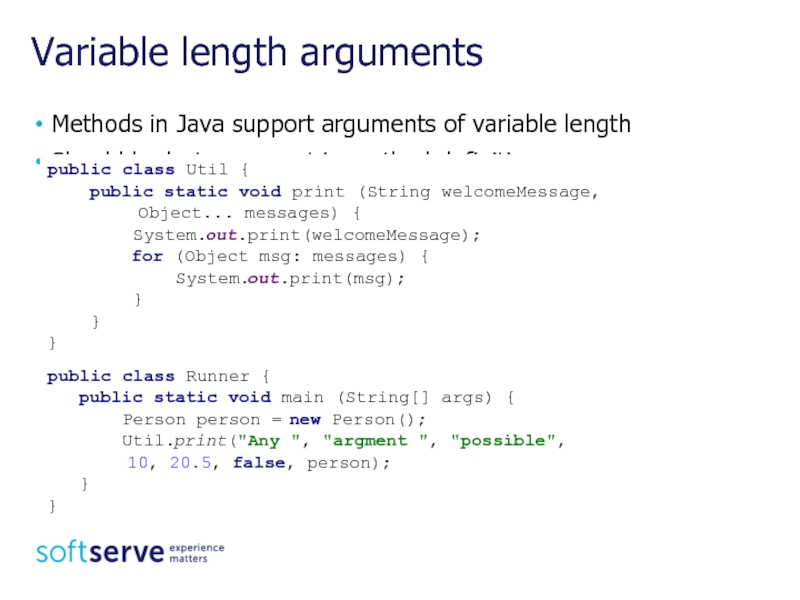
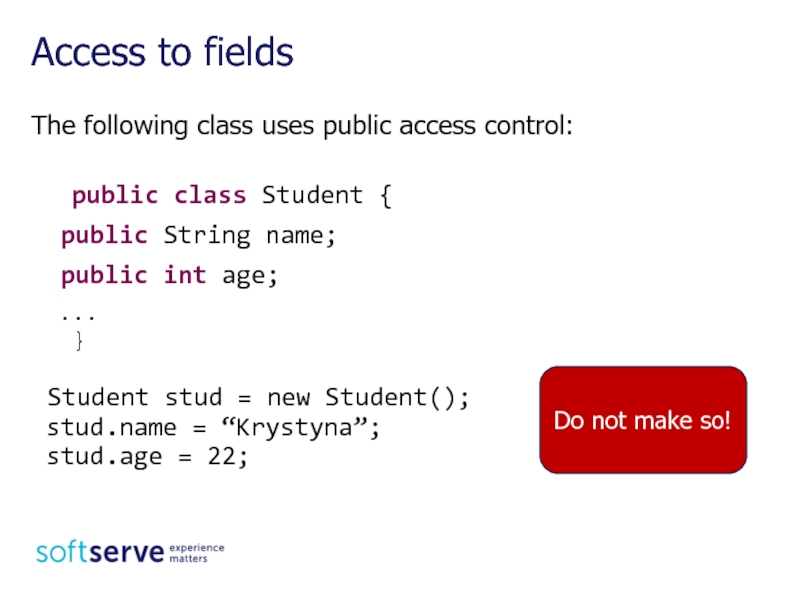
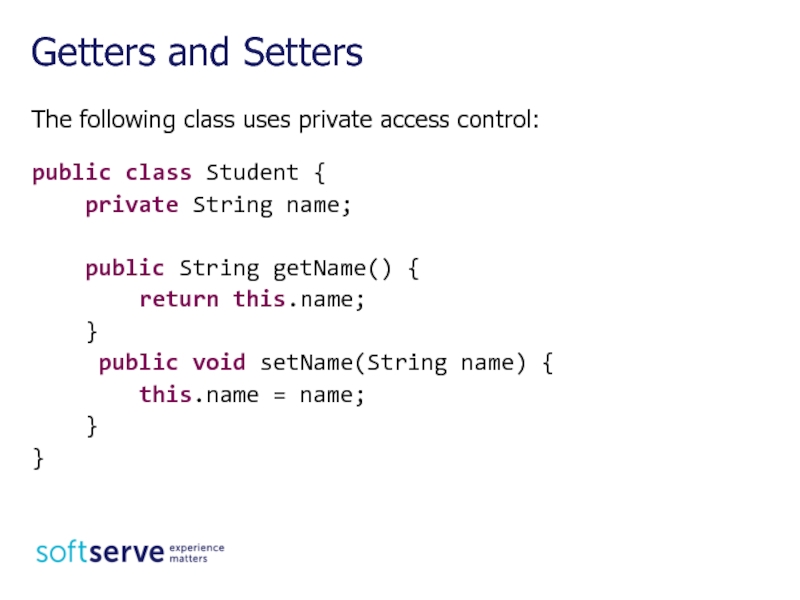
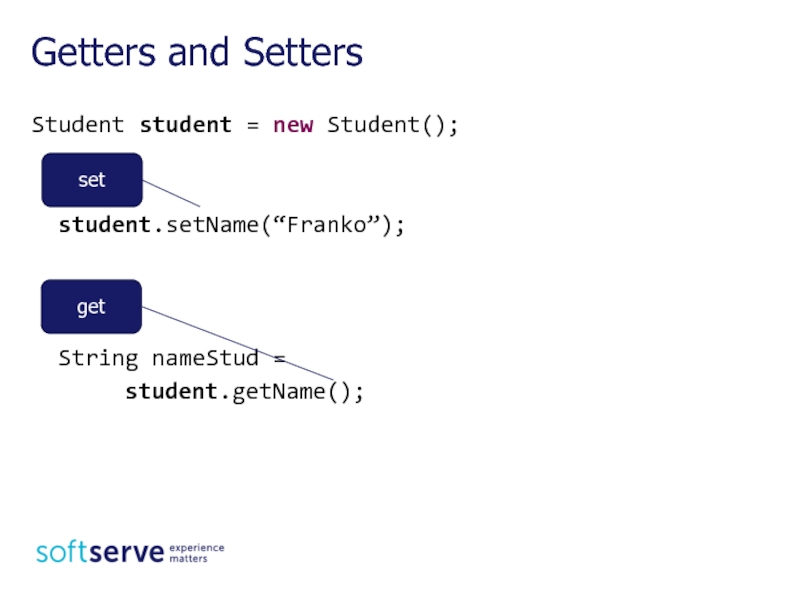
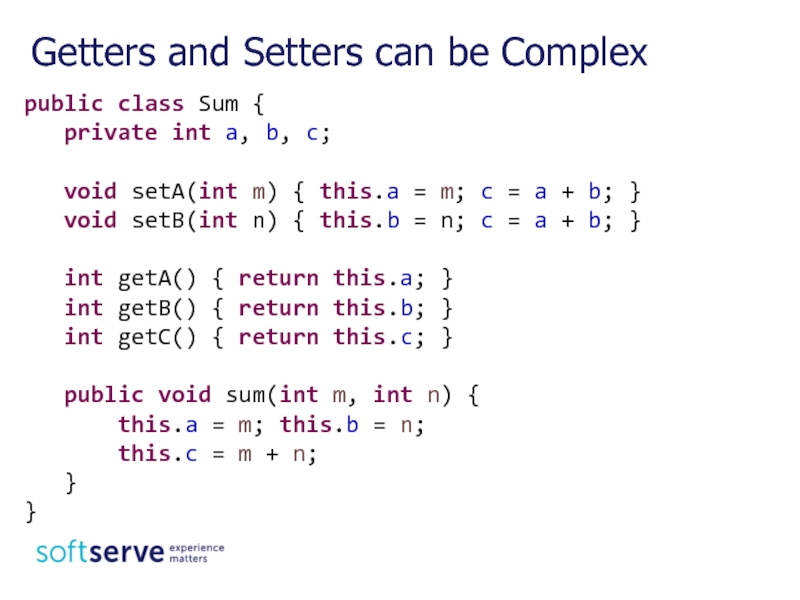
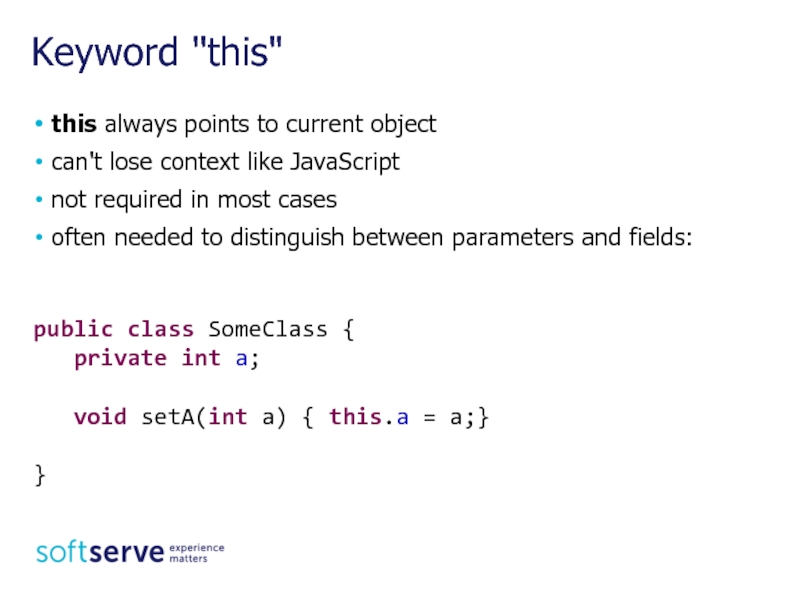
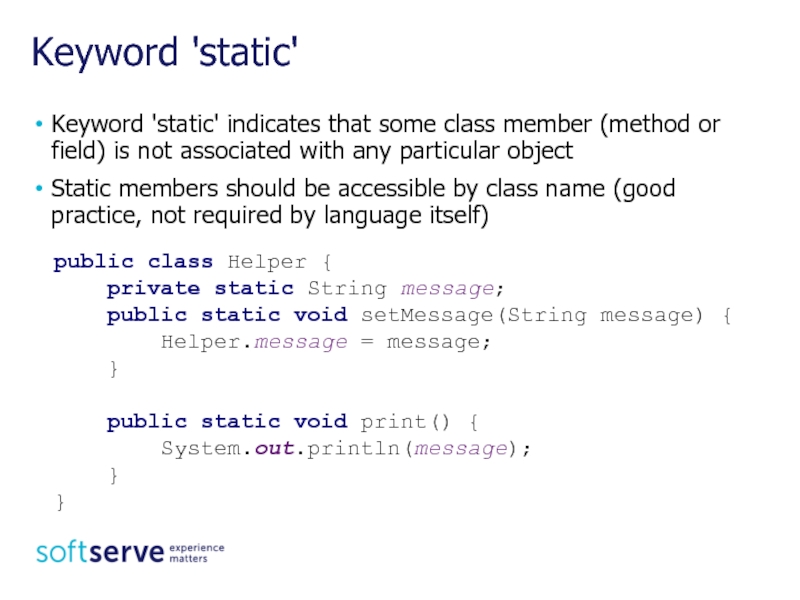
![Keyword 'static'public class Runner { public static void main (String[] args) {](/img/tmb/3/255433/368eacb2c975f8bbcb04c0537559d16a-800x.jpg)
